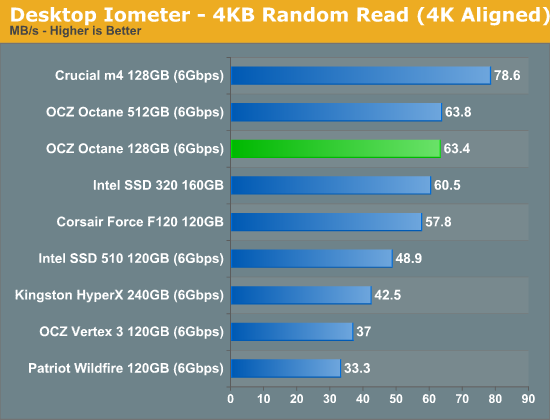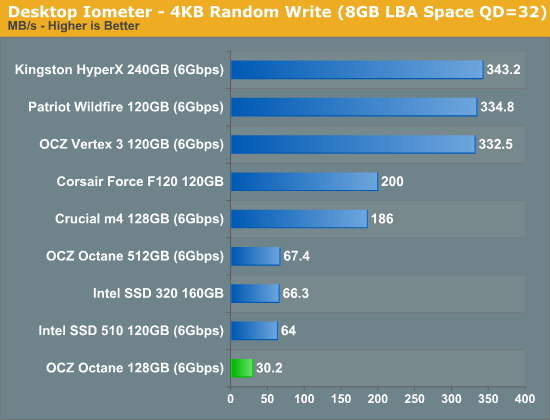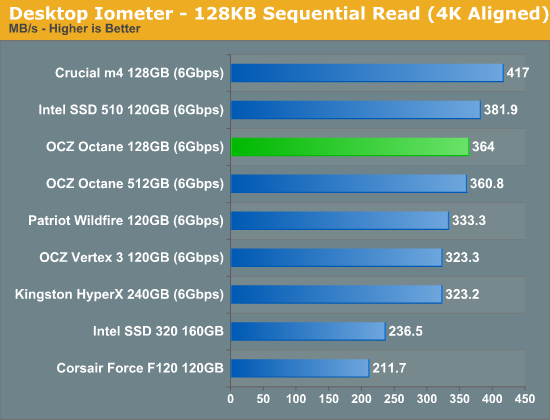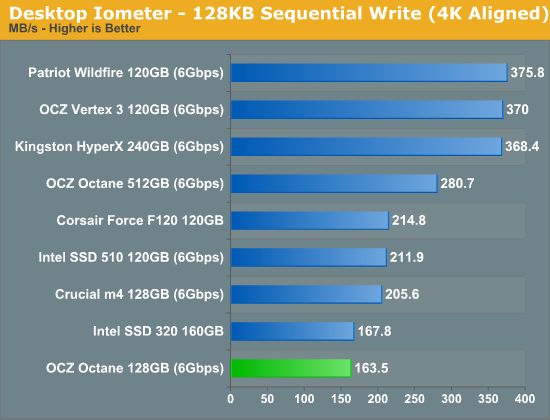OCZ Octane 128GB SSD Review
by Anand Lal Shimpi on December 28, 2011 12:27 AM ESTRandom Read/Write Speed
The four corners of SSD performance are as follows: random read, random write, sequential read and sequential write speed. Random accesses are generally small in size, while sequential accesses tend to be larger and thus we have the four Iometer tests we use in all of our reviews.
Our first test writes 4KB in a completely random pattern over an 8GB space of the drive to simulate the sort of random access that you'd see on an OS drive (even this is more stressful than a normal desktop user would see). I perform three concurrent IOs and run the test for 3 minutes. The results reported are in average MB/s over the entire time. We use both standard pseudo randomly generated data for each write as well as fully random data to show you both the maximum and minimum performance offered by SandForce based drives in these tests. The average performance of SF drives will likely be somewhere in between the two values for each drive you see in the graphs. For an understanding of why this matters, read our original SandForce article.

Random read performance remains untouched with the move to 128GB, although random write performance is cut in half compared to the 512GB version:

Many of you have asked for random write performance at higher queue depths. What I have below is our 4KB random write test performed at a queue depth of 32 instead of 3. While the vast majority of desktop usage models experience queue depths of 0 - 5, higher depths are possible in heavy I/O (and multi-user) workloads:

Sequential Read/Write Speed
To measure sequential performance I ran a 1 minute long 128KB sequential test over the entire span of the drive at a queue depth of 1. The results reported are in average MB/s over the entire test length.

Sequential read performance is once again untouched compared to the larger capacity Octane, while sequential write performance is seriously impacted:











38 Comments
View All Comments
yogi2k - Wednesday, December 28, 2011 - link
I guess your education must have been bad, seeing how the internet is global and not American.billegge - Wednesday, December 28, 2011 - link
Here is where I stand: I am a software developer and I develop within VM's, and VM's are IO intensive when running more than one VM on the same drive - thus I will choose a sandforce drive and not the Octane for the que depth. However, my daughter uses a netbook in a consistent manner - a very light workload and i think the Octane would suffice for her however the price point of the Octane is too close to the price of a Sandforce so I would rather go with the sandforce. BUT, OCZ is going to put out a Petrol version at a much lower price point - in this case and considering my daughter is running a 5400 RPM drive the Petrol should give her a significant boost at a price I would be happy with. So... I would like to see some Petrol benchmarks - but really mostly I would like to here from a live user their "experience" of the drive rather than benchmarks.Morg. - Thursday, December 29, 2011 - link
Simple answer : your daughter does not need an ssd, quit trying to spend money for no reasons.If she can survive a netbook without requiring a hammer, I don't see why she'd need an SSD.
krazyderek - Wednesday, December 28, 2011 - link
Would have been great to see the samsung 830 128GB drive in the same chartsTHANK YOU for the performance over time analysis that was missing from the original 512GB review due to logistics. I read these reviews for personal interest but also with an eye on them for something that a lightweight server could benefit from (at work).
todlerix - Wednesday, December 28, 2011 - link
Am I alone in being sore at OCZ for their sleazy means of making money? (Change NAND resulting in performance loss without changing the SKU or informing their customers.)To counter the nearly guaranteed "But they changed their ways!"
They only came clean once they were busted. If they were never caught the practice would still be an on going.
(Prepare for a cliche.)
They were only sorry they were caught.
MrCromulent - Wednesday, December 28, 2011 - link
I won't be buying OCZ for a long, long time as well. Besides their questionable business practices, every single one of my 5 older Indilinx Barefoot drives failed within one year.Firmware upgrades usually take a few hours. I have to test 5-8 PCs until I find one that lets me boot the DOS image and flash the drives without cryptic error messages.
FunBunny2 - Wednesday, December 28, 2011 - link
-- The smaller transistor geometry will eventually pave the way for cheaper drivesGiven the past history of geometry drops, I don't thinks so, if maintaining performance is taken into account. We've seen significant increases in over-provisioning with drops so far. Given that we know the physics gets non-linearly worse for each drop, I'd be surprised if a 20nm SSD with comparable performance will be cheaper.
sheh - Wednesday, December 28, 2011 - link
Looks like even after TRIM the drive is writing somewhat slower than it was (159 -> 134 MB)?And is HD Tach inaccurate in reporting burst speeds? Some of them are slower than the average.
SanX - Thursday, December 29, 2011 - link
New Year of course is an excuse but not like in this case: that was worst ever publication about SSDs-bad set of drives was taken. The mix of SATA2 and 3 is like comparing apples and oranges. Well it was ok when we had rare SATA3 drives. Not anymore. If Corsair is shown here with SATA2, it has to be shown with SATA3 too because it looks bad in this paper.
-non-substantiated predictions about pricing. Do you time the market? Prices strictly depend on market conditions --if market will nosedive like in 3 years ago in Mar 2009 the prices will follow below production costs. For example the 3 years ago we've already seen flash memory at $1/GB and see them again at this price point only now.
-No serious critics. Almost like on sites which are inherently interested to sell any cr#p they review. If this will happen, that will be the end of former great Anandtech. OCZ could easily make write performance of this drive in par with 512GB version taking same amount of smaller capacity NAND chips -- no suggestions or in-deep discussions why it was not done.
Don't drink and drive, Anand.
And Happy New Year
Spoogie - Thursday, December 29, 2011 - link
This drive has AES and Automatic Encryption, which is required for any drive I'll buy given that SSDs cannot be erased with current consumer technology.http://www.ocztechnology.com/ocz-octane-sata-iii-2...
Thanks for the review.